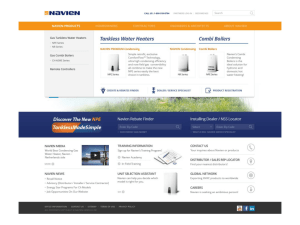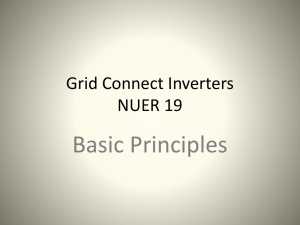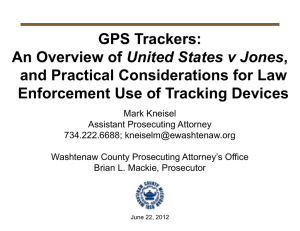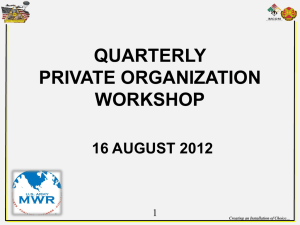safety - GRID Alternatives
advertisement
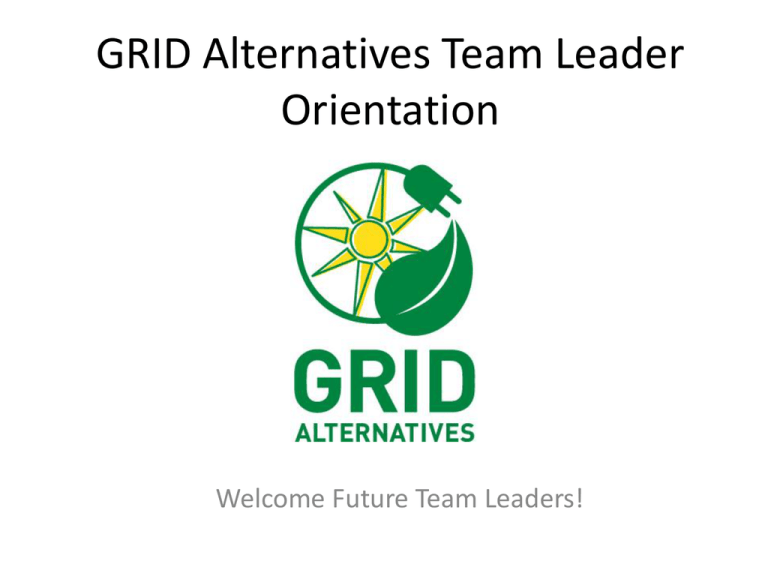
GRID Alternatives Team Leader Orientation Welcome Future Team Leaders! GRID Alternatives • Who? Non-profit solar installer. • What? Install solar PV systems for income-qualified homeowners. • How? Volunteers and job trainees install our PV systems. Team Leaders • Who? Anyone who attends at least one installation with GRID Alternatives and attends Team Leader Orientation can begin the process of becoming a Team Leader. • What? Team Leaders manage small groups of volunteers and teach skills essential to solar PV installation. • How? Team Leaders must demonstrate mastery of a set of skills and have each skill signed off on by a Solar Installation Supervisor (SIS) before becoming a Team Leader. • Why? Team Leaders get experience in a management role and also demonstrate leadership capabilities; traits that are desirable to potential employers. NABCEP Installation Requirements • Team Leaders can use their installations with GRID to fulfill the experience requirements for the NABCEP Professional Installers exam. • Depending on professional experience, Team Leaders must lead 3-5 ground installations and 3-5 roof installations (in addition to 58 hours of NABCEP approved classroom training) to become eligible to sit for the NABCEP exam. Please refer to the NABCEP Eligibility Requirements Summary Table to determine your required Team Leader installations. • Once Team Leaders have fulfilled these requirements they must contact their local Volunteer Training Associate for a letter confirming they have fulfilled the NABCEP installation requirements. NABCEP Installation Requirements Working Together on the Job Site Roof Team Leader Roof Team Ground Team Leader Ground Team SIS Team Leader Tools for Success • • • • • Quality Control Checklist Single Line Drawing Roof Plan Inverter Manual Module Cut Sheet Quality Control Checklist The Quality Control Checklist is an essential tool for the commissioning of a PV system. The checklist is broken down into sections referring to various parts of the installation. Roof checklist items include: • Racking • Microinverters • Modules • Junction Box • Raceways Ground checklist items include: • Raceways • AC Disconnect • Inverter • Wiring • Electrical Panel • Labeling Quality Control Checklist Within each section there is a sub-set of items to check. For example, in the module section there are boxes to check for the clamps being tight, module connections being tight, and the modules being properly grounded. Roof Plan Single Line Diagram Enphase Single Line Diagram String Inverter Module Cut Sheet Module cut sheets contain all the electrical information for the PV modules you are installing. On the cut sheet you can find a module’s Open Circuit Voltage (Voc) Short Circuit Current (Isc) and Maximum Power (Pmax). The cut sheets also give you the dimensions of your PV module. It is always a good idea to refer to the cut sheet for module dimensions when doing your layout. Inverter Manual Inverter manuals are a useful reference when wiring or hanging an inverter. Also, the inverter manual contains reference codes in case the system does not start up during commissioning. The inverter manual should always be left with the homeowner after installation. Being a Good Team Leader • SAFETY is the most important part of being a Team Leader. • Always err on the side of QUALITY over speed. • Don’t be afraid to ASK QUESTIONS. • Make sure volunteers are LEARNING and INVOLVED. • Remember you are REPRESENTING GRID Alternatives. Volunteer Management (R1 & G1) • • • • Be patient. Keep people busy. Be a teacher. Don’t allow any one person or group to dominate (i.e. tool grabbing). • Make sure volunteers respect each other as well as homeowner and neighbors. Being Patient… GRID Alternatives volunteers come from a wide range of backgrounds and vary in skill level. For example, some volunteers may be proficient in the use of power tools while others require a bit of teaching. Keep People Busy… It is important to assign tasks and roles to volunteers so they stay engaged. Everyone has more fun when they feel they are making a contribution to the installation. Be a Teacher… Demonstrate how to do something then let the volunteers do the work. No Domination… • Don’t let any one person or group dominate the installation. • An example of dominating the installation would be “tool grabbing.” • Again, make sure everyone is able to participate. Respect… • It goes without saying that we need to be respectful of each other while working. • It is also important to be mindful of the neighbors and the homeowner. • Be careful not to trample landscaping or do any damage to the homeowner’s home or the neighbor’s home. Safety First (R2 & G2) … and second … … and third… When in doubt ask! If you ever have any uncertainty on the job never hesitate to stop and ask your SIS for help. The most important thing is to maintain a safe working environment. General Site Safety • • • • Help SIS maintain safety protocols during projects Be able to deliver the morning Safety Talk Read and understand Site Safety Plan Ensure all volunteers: • • • • Sign the Liability Waiver Form Wear hard hats with name tag whenever on site Wear safety glasses and gloves Put on fall protection harness early and appropriately • Emergency Response Plan • Know where to find it • Carry out if SIS is incapacitated • Help monitor site conditions • • • • Rain, thunder, and lightning Natural disasters – fire, earthquake, high winds Extreme heat Threat of violence Common Safety Risks • Sunburn – Sunburn is the most common injury on the job in solar. Therefore, it is a good idea to apply sunscreen before you begin work for the day. Volunteers may not realize how long they will be working in the sun. Since Team Leaders are often times more experienced they should encourage other volunteers to apply sunscreen. • Dehydration/Heat Illness – After sunburn, dehydration is the next most common injury on the job in solar. It is critical to stay hydrated and avoid heat related illness. Make sure to take plenty of water breaks and rest in the shade when possible. Setting a water break timer is a good way to remember to take water breaks. PPE GRID Alternatives requires the use of PPE on the job site! It is your job as a Team Leader to ensure volunteers are wearing the appropriate PPE as required: • Hard hats are the first item on and the last item off: hard hats are required at all times on the job site. • ANSI Z87.1 rated safety glasses are always required when using power tools or near someone using a power tool (drills, impact drivers, and band saw). • Gloves are always required when handling flashings or other sharp objects, shingle or other abrasive objects, lumber, and during wire or rope pull. • The use of noise suppression headphones or single-use earplugs are required when exposed to excessive noise levels for long periods of time. Electrical Safety Hazards • Do not plug anything in without being told. • Always treat all wires as if they are hot. • Only the SIS or a licensed electrician authorized by the SIS are allowed in the main service panel. Electrical Safety Hazards Exposure and Energized Work • Volunteers are required to keep a minimum observance distance of 3.5 feet away from any open, energized service panel or inverter. • If physically within the 3.5 foot boundary of an open, energized service panel or inverter, the SIS or authorized electrician are required to wear safety glasses and insulated gloves with leather protectors and use insulated tools. • It is always better to de-energize the power source than control the potential safety hazard through the use of PPE. Electrical Safety Hazards Microinverter System Lockout/Tagout Protocol • The implementation of lockout/tagout kits are required in order to isolate any potential hazardous energy sources on site. The SIS will implement one of the following systems in order to isolate AC sources in microinverter systems: – Lockout and tag the entire main service panel when no one is working inside. – Do not install the solar breaker until after the junction box and AC disconnect have been wired and are closed. Lock the removed solar breaker until ready for installation. – If the solar breaker has been installed, lockout and tag the breaker until the junction box and AC disconnect have been wired and are closed and the system is ready for testing. Electrical Safety Hazards Central Inverter System Lockout/Tagout Protocol • The SIS will implement one of the following systems in order to isolate DC sources in central inverter systems: – Lockout and tag all homerun connectors AND any jumper connectors that are going into the junction box immediately after crimping. – Do not install connectors until the junction box and inverter have been wired and are closed. • AC sources can be isolated in the same way instructed in the microinverter protocol. Ladder Safety • Make sure all ladders are tied off before use. • The proper ladder angle is a 4:1 ratio with three ladder rungs extending past the eaves. • Always one person on a ladder at a time. • Never climb a ladder with tools in your hand. • Always maintain three points of contact with the ladder. Roof Safety • Never walk backwards on a roof and keep an eye out for tripping hazards. • Don’t place anything including tools and hardware on the edge of a roof. • If you drop something let it go and yell “headache” or “duck.” • If you are on the ground and hear “headache” or “duck” DO NOT LOOK UP. • Always ensure that you and your crew are implementing an appropriate fall protection system. When using personal fall arrest systems, volunteers must be secured to a lifeline and anchorage point before getting off the ladder. GRID Alternatives strictly enforces a 100% fall protection policy. Power Tool Safety • Always wear safety glasses when operating power tools. • Replace batteries when they start to feel low. • Teach volunteers the difference between the impact driver and drill, and their associated safety hazards. Safety Feedback Let us know how GRID is doing on safety! Go to http://www.gridalternatives.org/safety! Ground vs. Roof Team Leader • Ground Team Leaders are responsible for tasks such as hanging and wiring inverters, bending conduit, and pulling wire. • Roof Team Leaders are responsible for leading volunteers on the roof. They are typically responsible for assisting with the layout, proper installation of footings, rails, and the installation of modules. Skill Set Checklist • In order to earn your orange shirt and the title of Team Leader you must have an SIS sign off each skill on the Skill Set Checklist. • There is a separate list for Ground/Electrical & Roof Team Leaders. Getting Skills Signed Off • Aspiring Team Leaders should communicate with the SIS they are working with to get skills signed off. • It is important to let the SIS know which skills you would like to work on. • In the morning, either before or after the safety talk, is a good time to set goals for that day’s job. Roof Team Leader Checklist Skill Description (Must be able to train another volunteer) • • • • • • • • • • • • R1 R2 R3 R4 R5 R6 R7 R8 R9 O1 O2 O3 Volunteer Management Safety Protecting the Roof Locating Rafters Stand-off Installation Racking Assembly Junction Box Wiring Home Runs & Ground Wire Module Installation Tile Installation (Optional) Tilt-up Installation (Optional) Microinverters (Optional) Each skill has a corresponding reference code. Once you are proficient in a skill you can circle the reference code on the volunteer sign-in sheet and have your SIS sign off on that skill. R3 Protecting the Roof Flashing penetrations Carpet squares • It is also important to instruct volunteers to not drag their feet or sit on the ridge. • Team Leaders should let the SIS know if the roof is being damaged. R4 Locating Rafters Mallet Method Rafter Tail Method Are there any other methods of locating rafters? YES! If either method of locating rafters is not working, rafters can by located by looking in the attic. R5 Standoff Installation 1) Cut shingles R5 Standoff Installation 2) Install footing R5 Standoff Installation 3) Install flashing R5 Standoff Installation Is there anything missing from this photo? YES! There is a washer missing. 4) Install standoff R6 Racking Assembly Prosolar Racking System R7 Junction Box Wiring R8 Homeruns & Grounding Wire R8 Homeruns & Grounding Wire R9 Module Installation Always two people (four hands) to a module. No “solo” module carrying. R9 Module Installation Laying Module Aligning Modules R9 Module Installation Following torque specifications R9 Module Installation - - - - Note: Some AHJs do not allow the use of WEEBs for bonding; check your plans or ask your SIS if WEEBs are allowed for that job. WEEBs are a UL listed grounding component used to bond modules to rails. WEEBs should be installed perpendicular to and on top of a channel nut, spanning the channel of the rail. The “teeth” of the WEEB will penetrate the anodized coating of the module creating a metal to metal bond. WEEBs may not be reused. WEEB Location Wiley Electrical Equipment Bond WEEB No WEEB WEEB For arrays with an even number of modules WEEBs are installed between every other module. For arrays with an odd number of modules you will need to “double up” on the ends to completely bond all of the modules. R9 Module Installation NEGATIVELY GROUNDED, CENTRAL INVERTER SYSTEM WITH 2 STRINGS OF 10 IN PARALLEL STRING 1 GROUNDED STRING 1 UNGROUNDED + + - - + - + - + - + - + - + - + - + - + - + - + - + - + - + - + - + - + - + - JUNCTION BOX STRING 2 UNGROUNDED STRING 2 GROUNDED Prosolar Racking Specifications Fast Jack Details 72” Maximum spacing between Fast Jacks when using deep channel rail AND if the AHJ allows. O1 Tile Installation O2 Tilt Up Installation O3 Microinverters Engage Cable Enphase Microinverter M215 AC Wires Termination Cap Disconnect Tool Envoy Monitoring System O3 Microinverters Enphase Microinverters installed on rails, ready for modules. Ground/Electrical Team Leader Checklist Skill Description (Must be able to train another volunteer) • • • • • G1 G2 G3 G4 G5 Volunteer Management Safety Conduit Bending Inverter Wiring Inverter & Disconnect Mounting G3 Conduit Bending Line up the arrow on the bender with where you want to make your bend (Above) Apply constant pressure to the degree you would like to bend (Right) G3 Conduit Bending Conduit Support Two-hole Strap Strut Strap Conduit Strap One-hole Strap Strap within 3 feet of fittings and every 10 feet for EMT Conduit Bodies LB C LR LL T 90 Degree EMT Conduit Fittings Compression Connector (outdoor rated) Compression Coupling (outdoor rated) Compression Connector (concrete rated) Set Screw Connector (indoor) Set Screw Coupling (indoor) Box Connector G4 Inverter Wiring Inverter Wiring Power One Inverter G4 Inverter Wiring SMA Inverter Fronius Inverter Schneider Inverter AC & DC Disconnects DC Disconnect AC Disconnect G5 Inverter & Disconnect Mounting Installing inverter mounting bracket. Use at least two people to mount inverter on wall. Unistrut mounting method. Inverter and Disconnect Mounting Hardware Fender Washer Lag Bolts Unistrut Strut Nuts System Complete! NO Ready for final connection? Green Light From SIS The SIS will inspect and then turn on the system when ready! Let the net metering begin! Happy Homeowner Thank You Future Team Leaders!
